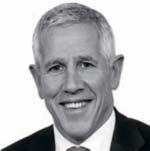MAKING ALTERNATIVE MAINSTREAM



Collective Insight is a collaborative initiative published quarterly by the Financial Mail. The articles included here were selected by an independent Advisory Commi ee to reflect some of the best insights from investment professionals, practitioners, and academics in relation to selected financial challenges.
Collective Insight enjoys the support of the Gordon Institute of Business Science’s Responsible Finance Initiative, the CFA Society of South Africa, the Financial Planning Institute, ABSIP and the Actuarial Society of South Africa. Our vision was to create a journal that SA’s broader investment community and its stakeholders could collectively “own”, carrying content totally independent of commercial interests.
For inquiries contact Anne Cabot-Alletzhauser on cabota@gibs.co.za
Convener: Anne Cabot-Alletzhauser

Practice director of the Gordon Institute of Business Responsible Finance Initiative
Editorial advisory commi ee: Simon Dagut Executive in the office of the chief executive officer, Standard Bank SA
Kelly de Kock
Chief operating officer at Old Mutual Trust Company
Prof Evan Gilbert
Associate professor at Stellenbosch University and strategist at Momentum Investments
Amanda Khoza
Vice-president and board member of the Institute of Retirement Funds SA.
Caretha Laubscher
Manager: Consumer Education Framework, Financial Sector Conduct Authority
Lelane Bezuidenhout
CEO Financial Planning Institute of Southern Africa
Nici McDonald
HOD: Certification and Standards, Financial Planning Institute of Southern Africa
Darius van der Walt
Member of the ASSA investment commi ee, head of product development at M&G Investments Southern Africa
Nerina Visser, CFA
ETF strategist and financial adviser etfSA
Ihave a teaching colleague who begins her lectures by showing a photo of a person wearing green sunglasses. The caption reads: “Once you see it, you can ’t unsee it.” This colleague is leading a class of MBA students through a programme on sustainability. She is alluding to this: no matter what your political or economic leanings, we now appreciate that to assess the risks and value embedded in a business thoroughly, we need to understand the social, environmental and economic context and implications. This means we need to understand how these externalities affect a business or how it, in turn, affects the world it inhabits.
This is heady stuff. Recognising this interconnectedness holds out the promise of the world of investments and finance achieving far more with the assets it controls. With more focused consideration, these assets could play a significant role in

heading off humanity’s inexorable march towards self-annihilation.
But can they really?
In the past few years there has been a frenzy of activity in the financial world to create a new breed of investments to tackle the double demands of providing financial returns and improving the quality of the world we must inhabit. What was once considered an “alternative” investment process or product is now being pushed into mainstream thinking. Fiduciaries considering the future of their pension fund members are demanding it. Policymakers are beginning to mandate it.
Investment practitioners are only beginning to understand how technically complex this “ask” actually is. Translating “intention” into “impact” would demand that investors consider investments that are now being classified as “alternative”— in other words, unlisted assets such as infrastructure, impact investments and private equity.
None of these is an “asset class” in the true sense of the word. Still, regulators impose exposure constraints on them for pension funds or collective investment schemes. More importantly, none of these classifications features in the modelling of asset allocation decisions that sit at the heart of a long-term investment strategy designed to fulfil a return expectation.
Much work has been done in finance over the past few years to create investments that provide financial returns, while also improving our worldAnne Cabot-Alletzhauser
Policymakers insist that environmental, social and governance (ESG) issues are considered when asset managers assess valuations and risks in their clients’ investment strategies. Nevertheless, practitioners are already pointing out that measuring ESG exposure does not necessarily translate into the impact or systems change investors expect.

This edition of Collective Insight begins an essential point of discussion. If investing needs to deliver more than just good returns, we must change our mindset about investments defined as “alternatives”. Instead, we need to develop solutions recognising how “integral” they are to achieving transformative goals. The articles that follow cover a broad array of issues that must now become mainstream: transitional finance solutions to address climate change; changing skill set demands for asset managers and asset consultants; listed investment vehicles that can house unlisted assets, making them accessible to all investors; and management engagements with the executive committees of listed assets to ensure that they are party to the transformation needs of society.
This edition simply starts the discussion. It still leaves out an array of additional steps that would also be critical for facilitating the culture change that will be required. The investment community will need new benchmarks to assess whether we are creating the required impact and earning the requisite returns. It will need new risk models to ensure the inclusion of these investments into our asset allocation decisions; it will need new performance metrics and reporting frameworks. Most importantly, we will all need to do something almost totally alien to the industry: collaborate competitor with competitor, asset owner with asset manager, and regulator with policymaker and with fiduciary.
In short, it’s complicated far more complicated than we first imagined. But it is not unachievable. All that’s required is a complete retooling of the current investment culture and processes. Right now, though, we are effectively “building the plane while we are flying it”. The real question is whether investors can persuade the investment industry to persevere until we have better clarity on building it so that it can “land” safely. x
For many retirement funds the biggest “impact” they have is the shock their members get when they reach retirement age and realise they will not be able to afford the same standard of living as before.
Yet the assets entrusted to the trustees of these funds are a valuable and powerful tool that, used appropriately, can have a meaningful effect on members and the wider economy and society at large.
Ensuring that the assets of a fund are invested in line with a sensible, long-term strategy is a critical task of the trustees. However, to unlock the true potential of retirement fund assets requires a shift in attitude not just from trustees but also from their asset consultants and asset managers. A mindset shift away from the comfort and familiarity of listed assets (with their high levels of transparency, scrutiny, regulations and oversight) is required. The reticence about investing in alternative assets is born partly out of a lack of experience with and knowledge of these types of assets.
Other factors, such as high fees, liquidity challenges and opaqueness are also deterrents. And investor discomfort is in no small way amplified by the prevailing level

of corruption in South Africa.
The term “alternative assets” is used to describe assets that are not traditional listed equities, bonds and cash. They are not a homogeneous group but encompass investments as diverse as private equity, private debt, direct real estate, hedge funds, infrastructure and commodities.
Though a willingness to embrace alternative assets is the starting point, attitude alone will not be enough for someone to confidently venture into this new and uncharted territory. As the story goes: “If you ’ve been playing poker for half an hour and you’re looking around and wondering who the patsy is, it’ s you. ” In investing it is dangerous to be out of your depth. A different, dare we say alternative, set of skills is essential to operate in this space.
A specific desire for investments to also have impact introduces a new lens through which to assess the types of alternatives. Most investments, traditional and alternative, have some sort of impact, but those with a direct developmental or infrastructure impact are predominantly unlisted equity or unlisted debt. Whereas listed assets are most often purchased in the secondary market (from other investors), unlisted assets are usually purchased in the primary market (from the original issuers), meaning that new fixed capital formation is taking place rather than just a change in the ownership of existing stock.
The nature of these unlisted or private assets makes strong due diligence skills and in-depth expertise essential for a person to be able to evaluate, select, negotiate,
In investing, it’s dangerous to be out of your depth. So when it comes to alternative investments, broader expertise is needed
CONSIDER THE ALTERNATIVE CAREFULLYResponsible Investment Initiative, Gordon Institute of Business Science
monitor and ultimately exit them.
Alternative investments have different performance and risk metrics than listed assets, and the diversification benefits can be significant. The limited correlation between alternatives and traditional assets is an attractive feature, as is the potential for sustainable long-run returns. But one of the reasons that alternative, unlisted investments have lower measured volatility than listed assets relates to the way these assets are priced: valuations are less frequent and are performed by specialists, which results in their prices being much more stable. Fundamentally, however, unlisted assets are subject to the same operating environments and similar financial constraints and profitability drivers as their listed counterparts. In fact, the methodology used to value unlisted assets often references metrics based on similar listed entities for example, the average p:e ratio.
There are two main reasons for returns between listed and private assets to be different: the illiquidity premium (extra return demanded by investors to compensate for the lack of liquidity) and the complexity premium (skills required to unlock opportunities). These two arise because complexity and illiquidity are deterrents that limit the pool of potential investors. Lack of liquidity requires patient capital, while complexity requires the skill to apply the process of identifying, negotiating, managing and exiting the investment.
For those trustees and their advisers who do decide to wade into the alternative investments pool, the inherent complexity means that they will have another important factor to consider: fees. The specialised skill sets in alternative investments and the level of due diligence required mean that the fees associated with these investments can be high. As is usual in evaluating fees for any investment, it is crucial to assess the level of extra return provided relative to the fees charged. If the fee structure disproportionately favours the asset manager, the premiums that are on offer to investors are eroded.
For defined contribution funds, which dominate the landscape in South Africa, liquidity is not a trivial consideration. For this reason, alternatives should be part of a comprehensive strategy and the appropriate allocation should consider the nature of the fund’s membership, the stability of the employer and the liquidity available in the rest of the portfolio.

To revisit the poker analogy, it’s not advisable to go all in on alternative investments. Careful management of the regular, reliable cash flows emanating from many types of alternative investments can serve to mitigate the illiquidity to some extent.
For example, the manager needs to plan entries and exits for deals and return of capital to investors. Trustees and advisers need to manage their allocation in the context of their overall portfolio and their specific liquidity needs.
Liquidity can potentially be managed by investing in a pooled vehicle that incorporates liquid and illiquid assets. A sometimes misunderstood feature of liquidity is that it is not constant, even for the same investment. The liquidity of a particular investment under normal conditions can change dramatically under conditions of stress. Seemingly ample liquidity at the time when the investment was initially assessed can evaporate quickly when market sentiment or conditions worsen. For this reason, liquidity should always be tested assuming worst-case scenarios.
The trend towards fewer, bigger retirement funds is also likely to play a role in enabling further investment into alternatives. While the amount of work and the complexity involved in allocating assets to alternative investments mean that only larger investors can have access to these opportunities or meet their deal size minimums, it also demands that these umbrella funds expand their skill sets to accommodate the complex requirements of due diligence, portfolio construction, monitoring and reporting. The economics do not make sense for smaller funds with a limited budget for alternative assets, particularly given the need to diversify across more than one fund or entity.
The predominance of listed assets in many retirement funds’ investment strategies limits their ability to use their assets to have a meaningful impact on the future of the South African economy. Having access to a wider set of opportunities offers the potential to improve the riskadjusted returns for members, leading to better, more consistent retirement outcomes. Beyond this, alternative investments that have real impact can also improve the futures of all South Africans, even if they are not fortunate enough to belong to a retirement fund. All it takes is a change in mindset. x
Billions of dollars have flowed into ESG-branded investments, with global environmental, social and governance (ESG) investing assets expected to rise to $41-trillion this year. Unfortunately, a large share of these assets has focused on constructing carbon-neutral portfolios, which have done little to reduce real-world carbon emissions.

It means that portfolios are created to avoid the problem, instead of solving it often, by simply limiting an investment universe to only the lowest carbon industries. This mechanistic approach may achieve portfolio purity, but it is likely to have little real-world impact and will starve emerging markets of capital. Dumping assets may feel virtuous, but could be ruinous.
Transition finance could lead the way To achieve real-world impact on issues such as net zero carbon commitments and climate change, transition finance provides a promising alternative.
For example, to help reduce carbon while achieving profitable returns, this could involve:
● Investing in some of the most challenging industries so that high emitters receive the capital and influence they need to transform their operations;
● Investing in new innovations and projects that might not be profitable initially;
● Funding vast infrastructure transformations; and
● Increasing exposure to emerging
DON’T LET VIRTUOUS
It may feel virtuous to dump carbon-intensive assets, but the move could be ruinous for emerging markets in particular. Financing the move to zero-carbon is a better option for companies, countries and investorsHendrik du Toit & Nazmeera Moola the Actuarial Society of South Africa
With 23 offices across 14 countries, we’re here for you and everywhere for your money. If it’s an offshore investment partner you’re after, there’s only one place to start. Right here.
Isn’t
Ę
Ninety One SA (Pty) Ltd is an authorised financial services provider.
Investing for a world of change
it time to change how you see investing?
markets, where emissions continue to grow the fastest and the need for all forms of support is greatest.
Essentially this is an investment process that supports the transition of high carbon-emitting companies and countries by actively engaging them to drive down emissions.
Investors might well ask whether such a focused, intensive strategy can be reasonably applied to global investment portfolios that could hold hundreds, if not thousands of shares. In fact, the universe of currently high-emitting companies is relatively concentrated.
To illustrate, at Ninety One, approximately fifty positions in our portfolio of nearly 1,200 companies account for about 70% of our financed carbon emissions. If we can successfully engage with those companies, work with them to develop credible transition plans and supply them with the capital they need to successfully implement them, we can have real-world impact.

It’s not just high-emitting sectors where transition finance is needed. Though they are responsible for only one-seventh of legacy emissions per capita, emerging markets and developing economies will likely account for 90% of annual global emissions growth by 2030.
What’s more, while emerging markets have historically contributed least to the problem, they are expected to suffer the worst physical impact of climate change. Given that most emerging market countries are yet to reach peak emissions, the choices these regions make as they build critical infrastructure to support economic development will shape climate risk for all the world.
The process of decarbonisation in emerging markets provides a growing and investable opportunity for private sector capital. There are two areas to finance where the convergence of investable opportunity and impact exists:
● Companies which will build the new infrastructure and technologies needed to power a net zero economy, such as renewable energy, battery storage, copper and lithium miners; and
● Investments by current high-emitting companies to decarbonise their operations, such as low-emissions cement, low-emissions chemicals and the phasing out of coal power energy systems.

Financing the investment in these two broad areas will not only achieve impact but will also offer investors an appropriate return. Support would be conditional on investee companies establishing credible transition plans that outline a strategy to help keep global warming to 1.5°C.
In order to avoid equity dilution, we believe many companies will tap debt markets, providing an opportunity for investors at attractive yields.
Are asset owners ready to finance the transition?

We recently surveyed 300 senior professionals at asset-owner institutions and advisers around the world to gauge their perspective on transition finance. The research found 60% of asset owners cite fighting climate change as a strategic objective, yet only 19% use transition finance in their portfolios. Fewer still (16%) say their fund invests in transition-finance assets in emerging markets.
By contrast, 22% of Southern African asset owners use transition finance in their funds, and 48% say it’s likely that they will invest in transition finance over the next 12 months. What differentiates these investments is that they may often be designed to make a real impact on more than just the climate, with goals related to working conditions, community uplift, and infrastructure development.
Could these strategies ever become mainstream?
Whether asset owners continue to integrate systems-change initiatives to deal with issues such as climate change or inequality or transformation into mainstream investment strategies will depend on whether they deliver the impact promised. We can’t afford simple or expedient solutions. This will demand a huge push to develop credible transition finance solutions. We can’t afford to get this wrong. x
at Ninety One
It’s high time retirement funds engaged with the alpha-adding potential of alternative investments in particular, the infrastructure sector. This is more than just being opportunistic about the diversification benefits of these allocations; it’s about the essential role the retirement fund industry can play in promoting economic growth while generating risk-adjusted returns.
The key is to ensure that there is an appropriate enabling environment to incorporate these assets into the pension fund management process. Recent changes in regulation 28 of the Pension Funds Act have provided the first steps for this shift by allowing retirement funds to expand their exposure to unlisted assets to 35%. Additionally, regulation 28 now stipulates a total cap on infrastructure investments of 45%.
Because these investments usually have a lengthy lifespan, they actually serve as a natural asset/liability match for retirement savings. But that also means that actuaries and asset consultants have to appropriately integrate infrastructure projects into the overall strategic asset allocation consideration for a fund. This will require them to map each infrastructure project to its relevant asset class (does the structure of each project suggest it will behave more like an equity, bond or prop-
Infrastructure investments are a no-brainer for pension funds, which need long-term assets to match their liabilities
Retirement funds interested in these investments should contact their asset consultant to get a sense of the various specialist service providers in the market.
These investments are largely accessible (either through private debt or equity funds) through pooling structures such as a policy of insurance (where one would enter into a pooling arrangement with a life insurer and own units alongside other investors with an economic benefit of the underlying assets), a partnership (where you become a limited partner among other limited partners with the service provider acting as a general partner) and, to a lesser extent, a unit trust structure regulated by the Collective Investment Schemes Control Act (CISCA).
This, however, is not the preferred method given the limitations placed on the ability of such vehicles to invest in projects that do not necessarily issue paper (which is an inherent CISCA requirement). x
erty investment?), as well as ascribe an appropriate risk and return expectation to each investment. This ensures that infrastructure gets fully integrated into the fund’s strategic asset allocation and risk budget.
Ultimately, for infrastructure investments to really be a viable choice for a pension fund, returns must be offered on fully commercial terms. Here again, some outside funding assistance might be needed. Subsidised finance can play a role in making some transactions bankable, but only through so-called Development Finance Institutions (DFI).
For institutional investors to access infrastructure investments, government first needs to address the infrastructure finance gap, which is expected to be approximately R1.9-trillion over the next two decades. The private sector (which also represents institutional investors), alongside government, can play a vital role in reducing the gap but, ultimately, legislation can only go so far and bankable deal flow is a requirement to feed the market.
COP27 provided one opportunity to attract attention to these funding needs. The COP27 Presidency announced a finance initiative that will enable African countries to borrow money at an affordable rate,
mobilise more green funding, and draw in private capital. France and Germany offered to contribute €600m to support South Africa specifically in its transition away from coal as part of a Just Energy Transition Partnership (JETP). The JETP investment plan will require a public-private sector partnership to support innovative financing methods for project and green finance. This, in turn, will provide more opportunity for retirement funds to access a variety of alternative investments.
On the local front, the South African government has announced a R300bn investment pipeline with a potential 19 green hydrogen projects for development, which is also promising.
The long-term viability of these deals depends on a clear and concise government policy that addresses how budgets are used across all departments of government. We are starting to see some success stories emerge from the establishment of Infrastructure SA and the Infrastructure Fund under the Development Bank of SA, but more can and should be done.
South Africa’s REIPP programme is a prime example of a successful publicprivate partnership. The programme has been running for the past 10 years, and its planned reform of the power sector and transition to cleaner energy has received international recognition and significant support.
Futuregrowth’s Power Debt and Infrastructure funds, for instance, have more than R8bn invested in 31 renewable energy projects that use a variety of technologies ranging from wind power, solar PV, and solar CSP to hydropower.
Why is all this important?
As asset managers, it is our fiduciary duty to act responsibly by allocating capital into those businesses that enable us to produce long-term, commercial returns for our clients while minimising risk.
This includes assessing both financial and nonfinancial (such as climate-related) risks, as part of our investment process, and integrating such considerations into a risk/return framework.
In short, enabling the integration of infrastructure investing into mainstream pension fund investments provides a potentially powerful means for South Africans to achieve both funding requirements and quality of life. x

There is clearly growing demand for access to alternative opportunities, through modern funding structures.
One particularly interesting development is for asset owners and sponsors to finance impact projects themselves, without a bank or private equity firm, and then facilitate liquidity in the secondary market via exchange listing and unitised access to the projects.
Traditional funding structures for a pension fund may include a bank-issued note giving the economic value of commodities, or investments via private equity funds with vested interests. Both cases may result in undesirable risk factors, restrictive contractual agreements and unexpected costs, including bank credit risk, long-term lock-ins or illiquidity on top of the underlying asset risk.
An alternative, without credit risk, is a listed security with direct financial or physical exposure to the desired equity or debt asset. Assets are ring-fenced for the benefit of the investor, providing risk mitigation to both investor and issuer, without the need for a bilateral agreement with either a bank or a private equity fund.
This investment vehicle represents a customised “security” according to the investor’s preferences, and the ring-fenced nature ensures there is no co-mingling or cross-contamination risk between assets. The risk to the investor is only to the nature of the assets held and their payoff profile.
The ability to collateralise investments in any range of impact projects, for example a physical infrastructure project, forest development, or social housing project, and list these on an exchange, is already available in Europe.
This innovation is delivered through a wrapper called an actively managed certificate (AMC) which is a single security, listed or unlisted, delivering the returns of a discretionary, dynamic portfolio.
Originally, it was designed to house a
•
•
basket of public market assets such as equities and bonds, but this has been extended to hold portfolios of renewable projects, agricultural ventures or educational infrastructure.
Legally, it gives the holder access rights directly to the underlying public or private assets that the AMC references. A key benefit is that the pension fund, as sponsor or anchor investor of the AMC, can set the terms of the investment portfolio as well as the rules around valuation, risk reporting and so on, something not possible for a bank-issued note or coinvestment with a private equity firm, which may not share the long-term outlook, risk appetite, social upliftment or environmental, social and governance criteria of the pension fund.
In South Africa, limited funding is available for impact project development; funding is often expensive and excludes smaller developers. Commercial banks may often misprice the risk of these projects, as their criteria and internal balance sheet constraints are different to the end investors’ liabilities.


This is noticeable when comparing corporate bond ratings for renewables despite a lower risk rating, funding is more expensive as banks cannot carry long-term loans when acting as intermediaries. This adds cost and misaligned priorities to impact projects such as sustainable food production which requires patient capital. The feasibility of the project is highly sensitive to all bank
“base” costs, which manifests through structurally high-interest barriers and technical conditions that undermine its viability, preventing access to funding for small-scale farmers.
Despite the increased security and regulatory oversight of an exchange listing, most investments flow through off-market fund platforms and/or private equity ecosystems. Global access to publicly listed assets opens a world of financing possibilities not readily available before.
It brings opportunities for all market participants, integrated in a single financial network. It results in savings, better transparency and less administration, and improves the risk diversification measures for a fund.
AMCs and the like provide oversight from the exchange through transparent frameworks, governance processes, cost disclosures and risk reporting standards. The exchange facilitates the ecosystem for independent valuation and auditing service providers.
The exchange acts as intermediary between the project(s) and multiple investors. The term “syndication” is used for carving up private investments to bring in multiple investors. We present carving up for public exchange in the form of securitisation with standardised regulatory transparency and disclosures.
Pension funds and institutions have a chance to make a real economic impact in
UNWRAP THE WRAPPERS
Known as actively managed certificates, these securities could be the best way for funders and investors to get transparent access, on an exchange, to impact projectsAndrew Wolfson & John-Michael Borcherds AMC STRUCTURE IMPACT (Multiple Projects with Multiple Investors) Independent auditing and reporting Asset manager of impact portfolio 3rd party investors Investment project portfolio (example) 35% in mining •30% in social housing 25% in agriculture •10% in recycling plant Sponsor provides the Funding for Impact Projects and appoints asset manager via SLA (ie seg mandate) Funding for project portfolio Sponsor appoints service provide to audit, report and value the impact projects Secondary market trading Independent valuationand risk reporting AMC references impact portfolio Exchange listing (i.e. unitisation) Sponsor or anchor investor (eg. pension fund)












































partnership with local exchanges to enable established and new investment vehicles to open public access for impact projects.
Progress has been hindered by an ecosystem that lacks transparency and costefficiency, and carries unwanted risks for the investor and sponsor.
But AMCs with no counterparty risk enable smaller impact projects. Their nature moves them beyond traditional restrictions of products such as exchange traded funds (holding a fixed underlying asset) to portfolios of assets and underlying projects that can change over time.
leverage and those with access to financial services and investment options in other words, by asset allocators.
Traditional exchanges need to adapt. The future-fit exchange has a broader and more important mandate to also facilitate new vehicles to raise capital and assets for impact projects. x
Ever tried getting a toddler to enjoy something that is vaguely good for them? It is beginning to feel as if world leaders need the same type of handholding as a two-year-old (cue eye roll).
The meeting of global climate change decision-making body COP27 has proved to be a nonevent. It is anecdotally reported that the number of fossil fuel lobbyists at COP this year was 25% higher than at last year ’s conference in Glasgow reflecting, to a large extent, the degree of realisation of the commitments made during previous rounds of the conference. Perhaps it sounds cynical, but leaders in developed countries as well as emerging markets have reneged on promises, bickered about expectations, extended deadlines and lightened the penalties for noncompliance.
Is it any wonder that climate activists are chaining themselves to the goalposts or throwing soup at Van Gogh’s Sunflowers? Is this not perhaps the last resort of a generation tired of pleading, of tolerating empty promises, of seeing toothless threats? And is this not the generation that will ultimately see the devastation if nothing changes?
The fight for climate justice is an intergenerational, intersectional global struggle. It is also a seemingly overwhelming task. So let us start small. Let us bring it home to South Africa.
Realistically speaking, the changes may need to be driven by those with financial
These institutional investors (the retirement industry and even the public sector) can demand access to alternatives focused on environmental, social and governance (ESG) considerations. We specifically mention alternatives, given that this class of investments (private equity, mezzanine debt and hybrid funding mechanisms) are known for their ability to channel institutional funds towards designated outcomes. We hope, however, that in the not too distant future access to alternative investments will be broader than the institutional pool of funds and that private or retail investors will be able to gain access more easily.
Realistically, however, we need to acknowledge that, despite there being semiprofessional boards of trustees, some institutional investors are still not sufficiently educated about this asset class. The industry therefore needs to prioritise education about alternatives, not only for ordinary citizens (often the implicit assumption), but also for trustees and financial advisers. The industry also needs to balance the desire for optionality with the phenomenon of analysis paralysis. Generally, people find it easier to make an informed choice between a more limited range of options. “Less is more” often holds true when it comes to investment options.
Another reality is that we need to make options palatable and accessible both for institutional investors and for the public. Historically and globally, we’ve seen that carrots and sticks don’t work, especially not from a developmental perspective. Just look at the history of aid and aid dependence in developing nations.
So why not try fish fingers? Like getting youngsters (or the majority of the world, in fact) to make the healthy choice, packaging it as something attractive and palatable does make progress towards the goal considerably easier.
The South African investment community, retirement industry and financial services providers appear to be building momentum, though still too slowly. Consequently, we have seen a few local offerings come to market. The aim is to balance the need for attractive returns with the need to “do good”

Some types of investment can be channelled more easily towards specific sustainable development goals. Private equity funds or mezzanine finance or hybrids can be designed to address specific goals, such as education, renewable energy or job creation. Managed by credible investment houses, with forward-thinking investment professionals, they can generate attractive long-run and sustainable returns.
Hurdles to investing in these products include that liquidity is limited (so investors are tied in for a specific period), that concentration risks are perceived to be higher, and that the required minimum investment amounts typically preclude investment by individuals or smaller institutional investors.
Yet there has been progress: asset managers already offer more liquid funds, with, for instance, one-month termination periods. Funds-of-funds solutions have also come to market recently. They offer a single access point to a “basket” of exposures to different products. Minimum investment thresholdsmay still be a tad steep for individuals, albeit manageable for small to midsized institutional investors.
As noted, the South African industry still has some way to go. Trustees, retirees, asset owners and asset managers are still finding their feet, like toddlers. Asset owners need to engage with service providers and communicate preferences and limitations regarding the use of alternatives and ESG expectations. And asset managers and service providers need to take time to gauge what the appetite is and to assess what is viable and palatable. But let us engage constructively, make our voices heard and take one another’s hands. x
Can we make ESG investment palatable and accessible and soon?structured investments at Orpheus Capital